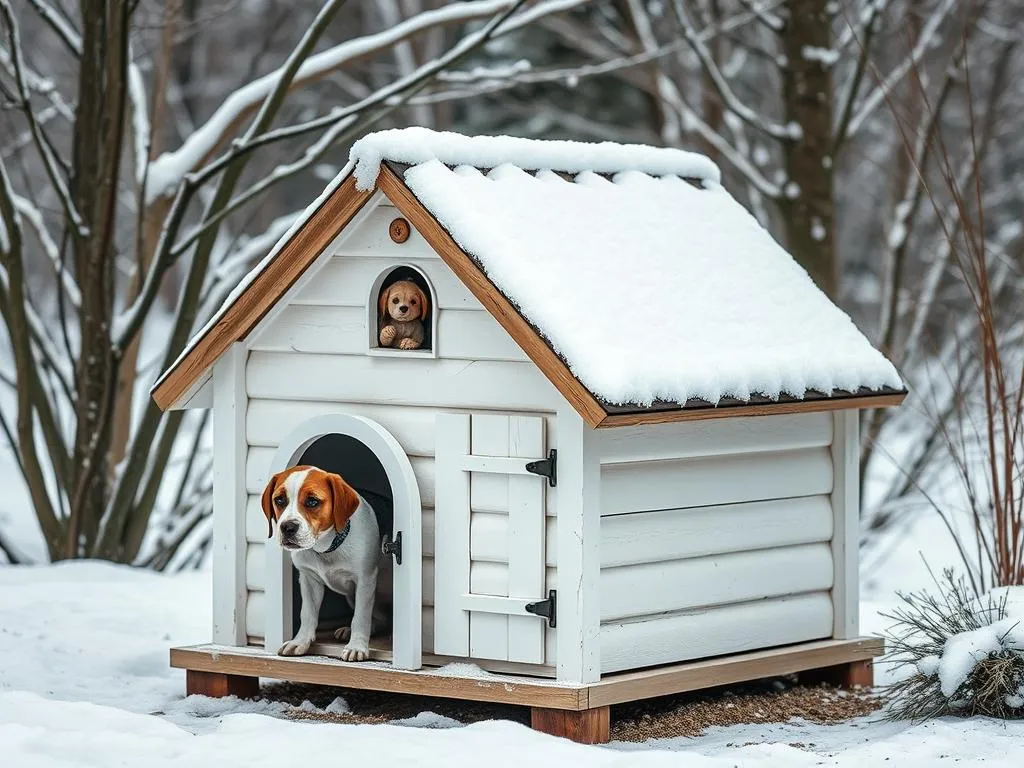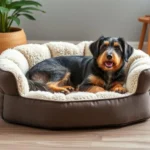
Providing adequate shelter for dogs during the winter months is essential for their well-being. A quality dog house can protect your furry friend from harsh winter conditions, keeping them warm, dry, and safe. When it comes to selecting the best dog houses for cold winter weather, several key factors come into play, including insulation, size, materials, and design features.
Factors to Consider When Choosing a Dog House for Winter
Insulation
Insulation is arguably the most critical factor when selecting a dog house for winter. Effective insulation keeps your dog warm by preventing heat loss and minimizing the impact of cold air. Here are some common types of insulation:
-
Foam Insulation: This is a popular choice due to its excellent thermal efficiency. Foam insulation can be added to the walls and roof to ensure maximum heat retention.
-
Straw: While not as effective as foam, straw is a traditional insulating material that provides decent warmth. It can be used as bedding inside the dog house.
-
Reflective Insulation: This type of insulation reflects heat back into the dog house, keeping it warm during the cold months.
Choosing a dog house with good thermal efficiency can make a significant difference in your dog’s comfort during winter.
Size
The size of the dog house plays a crucial role in maintaining warmth. A house that is too large will allow cold air to circulate freely, making it difficult for your dog to retain body heat. Conversely, a dog house that is too small will be uncomfortable and may restrict movement.
To select the right size, measure your dog while they are standing. The dog house should be tall enough for them to stand comfortably and wide enough for them to turn around. A good rule of thumb is to ensure that the dog house is about 25% larger than your dog’s measurements to provide adequate space without sacrificing warmth.
Materials
The materials used in constructing the dog house also significantly impact its insulation and durability. Here are some common materials and their pros and cons:
-
Wood: Wooden dog houses provide good insulation and are durable. However, they can be heavy and might require regular maintenance to prevent rot.
-
Plastic: Plastic dog houses are lightweight and easy to clean. They offer decent insulation, but they may not be as durable as wooden houses in extreme weather conditions.
-
Metal: While metal dog houses are very durable, they can retain cold temperatures and may not be ideal for winter use unless properly insulated.
Choosing the right material is essential to ensure that your dog stays warm and comfortable during winter months.
Design Features
When selecting a dog house for cold weather, consider the following design features:
-
A-frame vs. Flat-roof Designs: A-frame designs typically shed snow better than flat-roof structures, which can accumulate snow and moisture.
-
Raised Floor: A dog house with a raised floor helps prevent moisture from seeping in from the ground, keeping your dog dry and warm.
-
Sloped Roof: A sloped roof allows for better drainage of rain and snow, preventing buildup and moisture retention.
Door Type
The door type of a dog house is another consideration for keeping your dog warm.
-
Flap Doors: Flap doors are effective at keeping drafts out while providing easy access for your dog. They can also help retain heat inside the house.
-
Solid Doors: While solid doors may offer better insulation, they can be challenging for dogs to navigate, especially if they are elderly or have mobility issues.
Ensuring that your dog house has proper draft protection is essential for maintaining warmth.
Top Features of the Best Dog Houses for Cold Weather
Weather Resistance
The best dog houses for cold winter weather should be constructed from waterproof materials to protect against snow and rain. Look for dog houses that have been specifically designed for weather resistance, featuring sealed joints and roofs that prevent water ingress.
Ventilation
Proper ventilation is crucial to prevent moisture build-up inside the dog house. Good ventilation allows fresh air to circulate while keeping cold drafts at bay. Features that promote air circulation include:
- Vents located near the roof line
- Adjustable flaps to control airflow
- Raised floors to increase airflow underneath the house
Ease of Cleaning
Maintaining hygiene is vital during winter, especially when the dog house may become a haven for moisture and bacteria. Look for features that facilitate cleaning, such as:
- Removable roofs for easy access
- Floors that can be lifted or cleaned without hassle
- Smooth surfaces that can be wiped down easily
Reviews of the Best Dog Houses for Cold Winter Weather
Product 1: Petmate Indigo Dog House
-
Overview and Features: The Petmate Indigo Dog House features an igloo design that provides excellent insulation and a waterproof roof. It has a raised floor and is made of durable, weather-resistant materials.
-
Pros and Cons:
- Pros: Great insulation, easy to clean, durable.
-
Cons: May be too small for larger breeds.
-
Ideal For: Medium-sized dogs looking for a cozy place to stay warm.
Product 2: Suncast Outdoor Dog House
-
Overview and Features: This dog house features a durable resin construction that is both weather-resistant and easy to clean. It has a raised floor and a sloped roof to ensure proper drainage.
-
Pros and Cons:
- Pros: Lightweight, easy to assemble, good ventilation.
-
Cons: Not as insulated as some wooden options.
-
Ideal For: Small to medium-sized dogs that require a basic shelter.
Product 3: TRIXIE Pet Products Natura Dog House
-
Overview and Features: The TRIXIE Natura Dog House is made from solid wood with a weatherproof finish. It features a raised floor and adjustable feet for leveling on uneven ground.
-
Pros and Cons:
- Pros: Sturdy construction, great insulation, aesthetically pleasing.
-
Cons: Requires assembly.
-
Ideal For: Dogs that need a stylish yet functional outdoor shelter.
Product 4: Advantek The Original Pet Gazebo
-
Overview and Features: This innovative dog house features a sturdy frame with a weather-resistant cover. It offers excellent ventilation and a unique design that protects against the elements.
-
Pros and Cons:
- Pros: Lightweight, portable, great airflow.
-
Cons: Not suitable for extremely cold climates without additional insulation.
-
Ideal For: Active dogs that enjoy being outside in various weather conditions.
Product 5: K9 Kennels Dog House
-
Overview and Features: The K9 Kennels Dog House features an insulated double-wall construction that provides excellent warmth and comfort. It has a sloped roof and is designed for extreme weather conditions.
-
Pros and Cons:
- Pros: Superior insulation, durable, easy to clean.
-
Cons: Higher price point.
-
Ideal For: Large breeds requiring extra insulation and space.
DIY Options for Building a Dog House for Winter
Materials Needed
If you’re handy and want to create a custom dog house for winter, here are the materials you’ll need:
- Plywood or insulated panels (for walls)
- Wooden beams (for structure)
- Waterproof roofing material (shingles or metal)
- Insulation (foam or straw)
- Hinges and screws (for doors)
- Paint or sealant (for weatherproofing)
Step-by-Step Guide
-
Design Your Dog House: Sketch a design that allows for insulation and good drainage. Aim for a size that fits your dog snugly.
-
Cut the Panels: Cut the plywood or insulated panels according to your design measurements.
-
Assemble the Base: Use wooden beams to create a sturdy base. Ensure it is raised off the ground to prevent moisture seepage.
-
Construct the Walls: Attach the wall panels to the base, ensuring they are secure.
-
Add Insulation: Install insulation between the wall panels before sealing them up.
-
Install the Roof: Attach the roof panels, ensuring they are sloped for drainage.
-
Add the Door: Install a flap door or solid door with hinges for easy access.
-
Weatherproof: Paint or seal the exterior to make it weather-resistant.
Tips for Customization
- Personalize with Paint: Use weather-resistant paint to customize the look of the dog house.
- Add Ventilation: Consider adding vents or windows for airflow.
- Include a Porch: Create a small porch area for your dog to enjoy the outdoors.
Maintenance Tips for Winter Dog Houses
Regular Inspections
During the winter months, regularly inspect the dog house for any signs of wear and tear. Look for:
- Cracks in the walls or roof
- Signs of moisture damage
- Loose or missing shingles
Addressing these issues promptly will help keep your dog safe and warm.
Cleaning Routine
To maintain cleanliness during winter, establish a cleaning routine:
- Remove bedding and clean the interior weekly.
- Wipe down surfaces with a mild disinfectant.
- Ensure that the area around the dog house is free from debris and moisture.
Preparing for Extreme Cold
As temperatures drop, consider additional measures to keep your dog warm:
- Add extra bedding, such as straw or blankets, for insulation.
- Use heating pads designed for pets, placed under the bedding but away from direct contact.
- Create windbreaks around the dog house using tarps or fencing.
Alternatives to Traditional Dog Houses for Winter
Heated Dog Houses
Heated dog houses are an excellent option for dogs that require extra warmth. These come in various designs, with some using electric heating elements while others rely on insulation.
-
Electric Options: These houses are equipped with built-in heaters. They provide consistent warmth but require access to power and careful monitoring to ensure safety.
-
Insulated Houses: While not electrically heated, these houses provide superior insulation to keep warmth trapped inside.
Indoor Alternatives
During extreme winter weather, consider bringing your dog indoors. Create a comfortable space with:
- Soft bedding in a quiet area.
- Dog gates to create a safe space.
- Toys and blankets to keep your dog entertained.
Dog Crates as Temporary Shelters
If your dog is crate-trained, a sturdy dog crate can serve as a temporary shelter during winter storms. Ensure that the crate is:
- Covered with blankets for insulation.
- Placed in a draft-free area.
- Equipped with soft bedding for comfort.
Conclusion
Providing your dog with proper shelter during the winter months is crucial for their comfort and safety. When selecting the best dog houses for cold winter weather, consider factors such as insulation, size, materials, and design features.
Evaluate your dog’s specific needs and environmental conditions to ensure they remain warm and happy. Whether you choose a pre-made dog house, build your own, or opt for indoor solutions, the goal is to create a safe haven for your furry friend throughout the chilly months.









